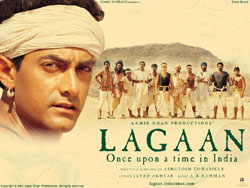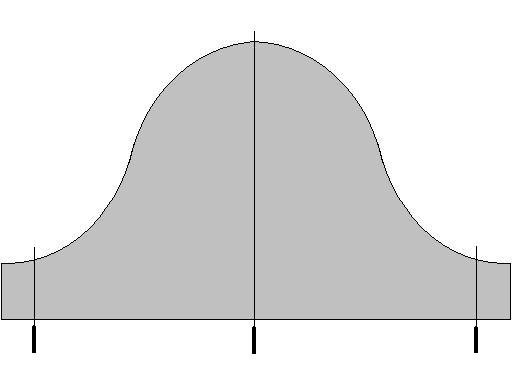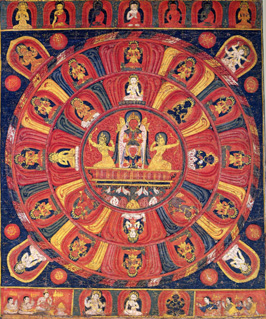
Robert Langston
langstonrob@juno.com
IN THE LIGHT
A scene in the Bollywood movie”Lagaan” begins with a down trodden Indian cricket team of Indian villagers, facing a high stakes game against their colonial era oppressors in which they have wagered their livelihoods . Their initial defeat have left them faced with the all too likely prospect of losing their means to survive and exist as a community.... From the hilltop temple a voice in song is heard; the women of the community have gathered there in devotion to petition thier deity Lord Krishna to save them from what seems like certain doom. The villagers join in the following lyrics from the song O Paalanhaare:
Chanda mein tumhe to bhare ho chaandi
It is you who has filled the moon with moonlight
Sooraj mein ujaala tumhe se
The sun’s brightness is from you
Yeh gagan hai magan, tumhe to diye ho isse tare
The sky is content you have given stars to it
Bhagwan, yeh jeevan tumhe na sanwaaroge
God, if you don’t adorn this life
To kya koi sanwaare
Then who will adorn it
O paalanhaare, nirgun aur nyaare
Oh nurturant Lord, beyond description and beyond all
Tumre bin hamra kaunon naahin
Without you we have no one
___________ AND____________
Jag ke jo swami ho, itni to araj suno
Since you are the world’s master, please hear this plea
Hai path mein andhiyaare
There is darkness in our path
Dedo vardaan mein ujiyaare
Provide us with blessed lightDiscussion:
1) What is the tone of voice or flavor of the verse? Sentmental?Odious? Pathetic? Comedic? Romantic?
2) What are the primary motifs and metaphors throughout the song?
3) What religion is the song grounded in?Associating the light of celestial objects to the God is pretty obvious. Here God causes the moon, and the sun, and the stars to shine. The idea that the presence of God is everywhere that we look is, for the common person, at best is recognized in rare moments; times of distress and uncertainty, times of extreme happiness and good fortune, or times of reflection. Metaphoric clues encoded in common and everyday language remind and communicate to lay society what is to often rlegated to esoteric thought and experience . The film makes possible esoteric and abstract ideas through expression in popular culture. Although almost everyone experiences light physically, fewer and fewer people actually are aware of light as a spiritual experience.
Compare the lyrics of "O Paalanhaare" to a song from the 12th century Tibetan Buddhist Saint, Milarepa
From Song on Nature and Mind:
“...Think of mind as sky:
Conceptual thoughts like clouds obscure it,
But an oral instruction from a genuine lama
Will blow away the clouds.Conceptual thoughts are clear light
And experiences shine like the sun or the moon
Beyond time, beyond mandala
Beyond reference point, beyond wordsTruths are as bright as stars
What dawns is great bliss
Natural, genuine dharma body
Empty of conscious conditioning…”Riggs, Nicole, Milarepa: Songs on the Spot ( Eugene: Dharma Cloud, 2003 )
Categories of commonly shared experiences of light are distinguished to show how increasingly abstracted and indirect kinds of light and its explanations derive meaning and association from fringe positions in society.
Sun Sustains life, regulates time, gives direction, gives warmth.
Illuminates objects to define textures, patterns, the most colors and forms
Casts shadows.
Always rises.
Obscured by weather, geography or atmospheric pollution.
Celestial Regulates time and gives direction for navigation and prophecy.
Obscured by weather or light pollution.
Fire Protects from cold and wild animals.
Illuminates objects with less intensity, and limited color during the night or indoors.
Cooks food.
Āratī, offering to Gods.
House and street lights Illuminates objects with less intensity, and limited color during the night or indoors.
Film and Television Transports, multiplies and animates images within in a local space.
Illuminates objects with varying intensity and color.
Psychological & Spiritual Experienced internally as a product of spiritual achievement.
Describes the experience of the yogin.
Describes metaphysical concepts.
The people who experience these kinds of light in terms of can be charted in the form of a bell curve.
Esoteric, Inward
ExperienceObservable,External
ExperienceEsoteric, Inward
Experience
The various experiences of light narrow as it becomes realized in more and more abstracted terms.
I-----------------------------------------------Sun---------------------------------------------I
I---------------------------------------Celestial Bodies--------------------------------------I
I-----------------------------------------------Fire--------------------------------------------I
I---------------House and Street Lights-------------I
I----------Film and Television---------I
I-------Intellectual------I-Psychological-
-Spiritual-
In the esoteric world of Mahayana and tantric mysticism of Buddhist and Hindu thought, mandalas, yantras and cosmograms map out worlds which were revealed only to the intiated. Today, these same images are commonplace in museums and coffe table books.
|
|
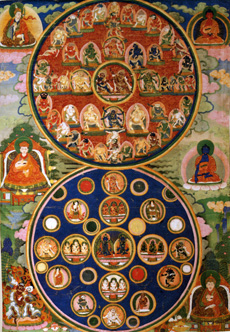 Bardo Thodol |
|---|
Diana Eck's book “Darśan: seeing the Divine Image in India” describes the tactile quality of light. We experience warmth under most light. So there is a tactile quality to seeing. In this sense, seeing is experienced and conceptualized as a kind of touching.
 |
 |
Looking at examples from other traditions of art, make some comparisons regard what part light plays.
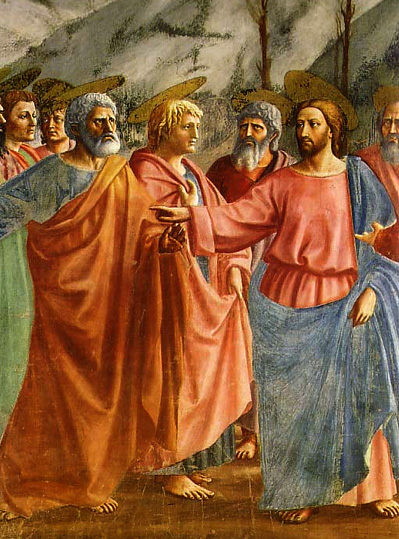 |
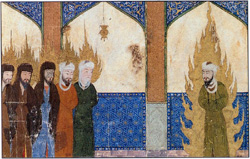 |
 |
